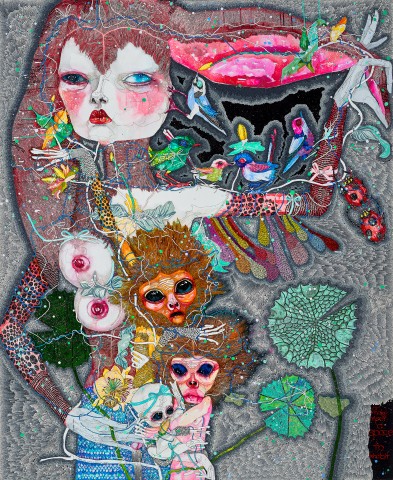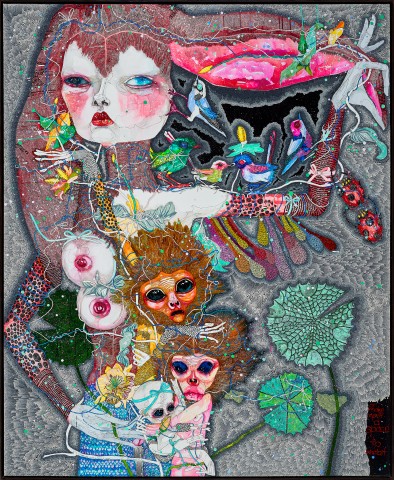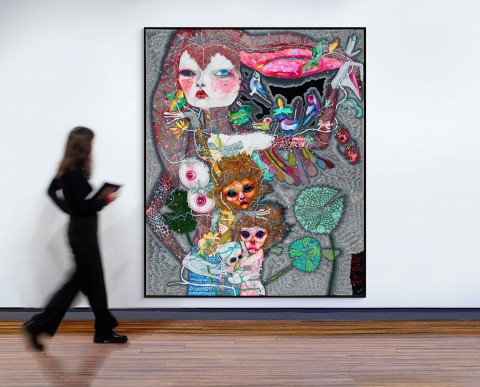OR MAKE MYSELF A SPACE TO INHABIT, 2007
DEL KATHRYN BARTON
synthetic polymer paint, gouache, watercolour and ink on canvas
220.0 x 180.0 cm
signed, dated and inscribed with title lower left: or make myself a space to inhabit del kathryn barton 07
inscribed with title lower right: or / make / myself / a / space / to / inhabit
signed, dated and inscribed with title on stretcher bar verso: or make myself a space to inhabit del kathryn barton 2007
Karen Woodbury Gallery, Melbourne (label attached verso)
Private collection, Sydney, acquired from the above in 2007
Del Kathryn Barton, the whole of everything, Karen Woodbury Gallery, Melbourne, 5 March – 5 April 2008
Woodbury, K., (ed.) & Colless, E., Del Kathryn Barton, the whole of everything, Karen Woodbury Gallery, Melbourne, 2008, pp. 6 – 7 (illus.)
Gardner, A., ’Del Kathryn Barton: A paradox of ecstasies,’ Art and Australia, Sydney, vol. 45, no. 3, 2008, cover (illus. detail), pp. 323, 428, 433
250132 (2).jpg
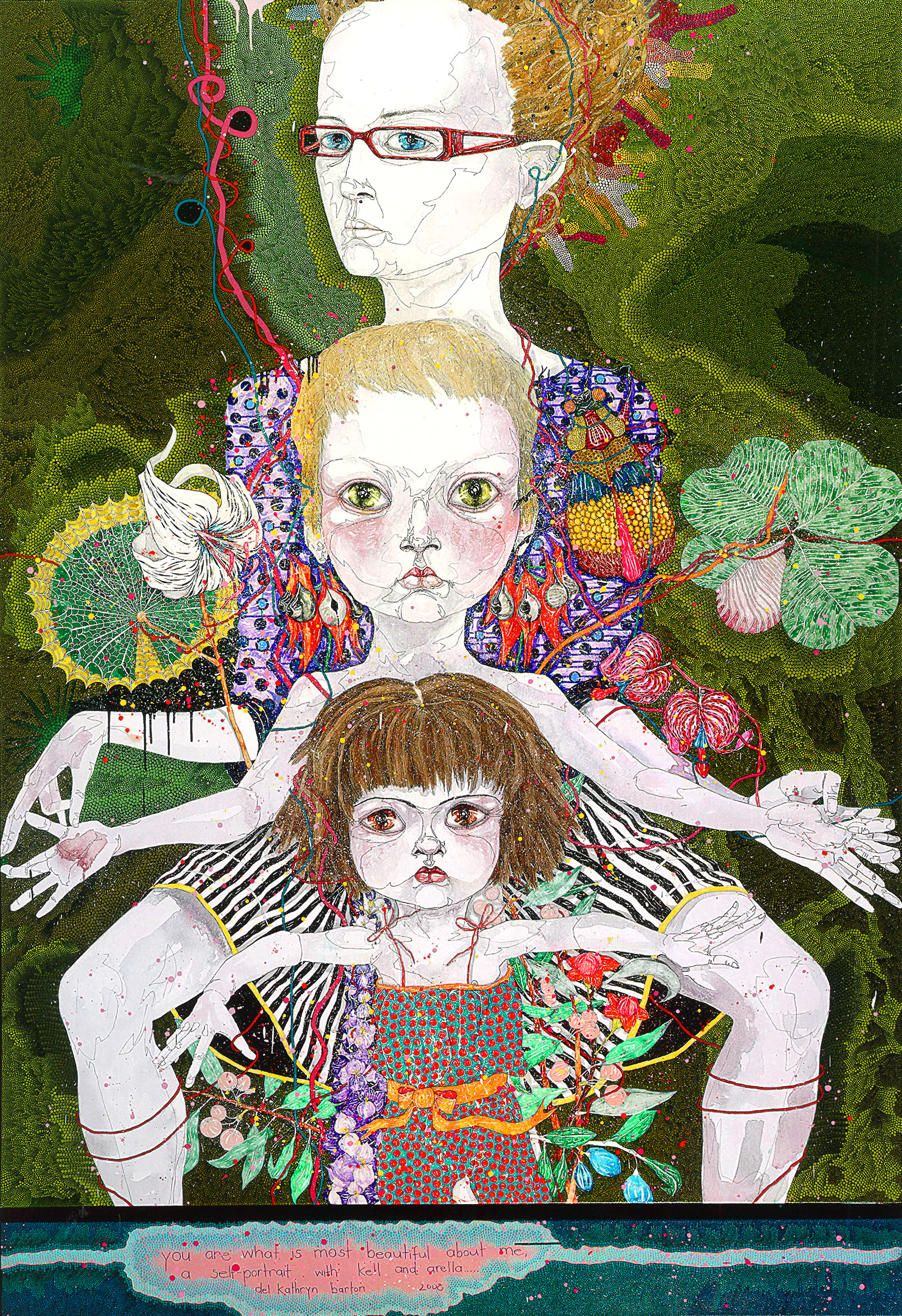
The sirens of Del Kathryn Barton’s sumptuous mystical world are caught mid-metamorphosis, radiating energy from their pale skin into a dark and starry void. With the shallow pictorial perspective of a Byzantine icon or a medieval tapestry, the rabbit-eared goddess of Or make myself a space to inhabit, 2007 is depicted in a striking pose, profusely adorned and richly embellished with decorative details. Gathering simian infants to her breast and with technicolour birds and a pair of ladybugs perched on her arm, she is a protectress, a fierce icon of enchanted motherhood.
In March 2008, Barton’s hyper-decorative homage to the all-encompassing love of motherhood You are what is most beautiful about me, a self-portrait with Kell and Arella, 2008 won the most coveted of all Australian art prizes, the Archibald Prize for Portraiture. Writing in her artist’s statement, Barton explained: ‘The intensity of this emotion is not something that I could have prepared myself for. The alchemy of life offered forth from my inhabitable woman’s body is perhaps the greatest gift of my life.’1 Painted at this pivotal point in Del Kathryn Barton’s career, with her star in ascendence, Or make myself a space to inhabit similarly addresses the theme of maternal protection and nourishment. A key work in her solo exhibition Del Kathryn Barton, the whole of everything, at Melbourne’s Karen Woodbury Gallery, this painting was reproduced on a large banner in Melbourne’s central business district. Also featuring on the cover of Art and Australia’s Autumn 2008 issue, this painting enjoyed unrivalled public exposure.
A mature work by an artist reaching the height of her powers, Or make myself a space to inhabit confidently and unapologetically displays a beguiling profusion of details, a dense cornucopia of real and imagined elements enticing the viewer into the artist’s Romantic and Symbolist realm, tumbling like Alice into a disorienting dreamscape. Barton’s horror vacui – the creative urge to cover the entire surface of her paintings with pulsating and scintillating patterns and small decorative motifs – is often said to be inspired by the works of Viennese Secession artist, Gustav Klimt, whose symbolist paintings also combined daring psycho-sexual subject matter with patterned backgrounds. For Barton, the thousands of meticulous dots and snaking inky lines of ribbons and filaments animate the surface and ‘attempt to impart a quality of energy.’2 The obsessively radiating waves throughout the background of this painting evoke the shimmering monochrome paintings of Lily Kelly Napangardi’s Tali desert sandhills, shifting in the wind.
250132.jpg
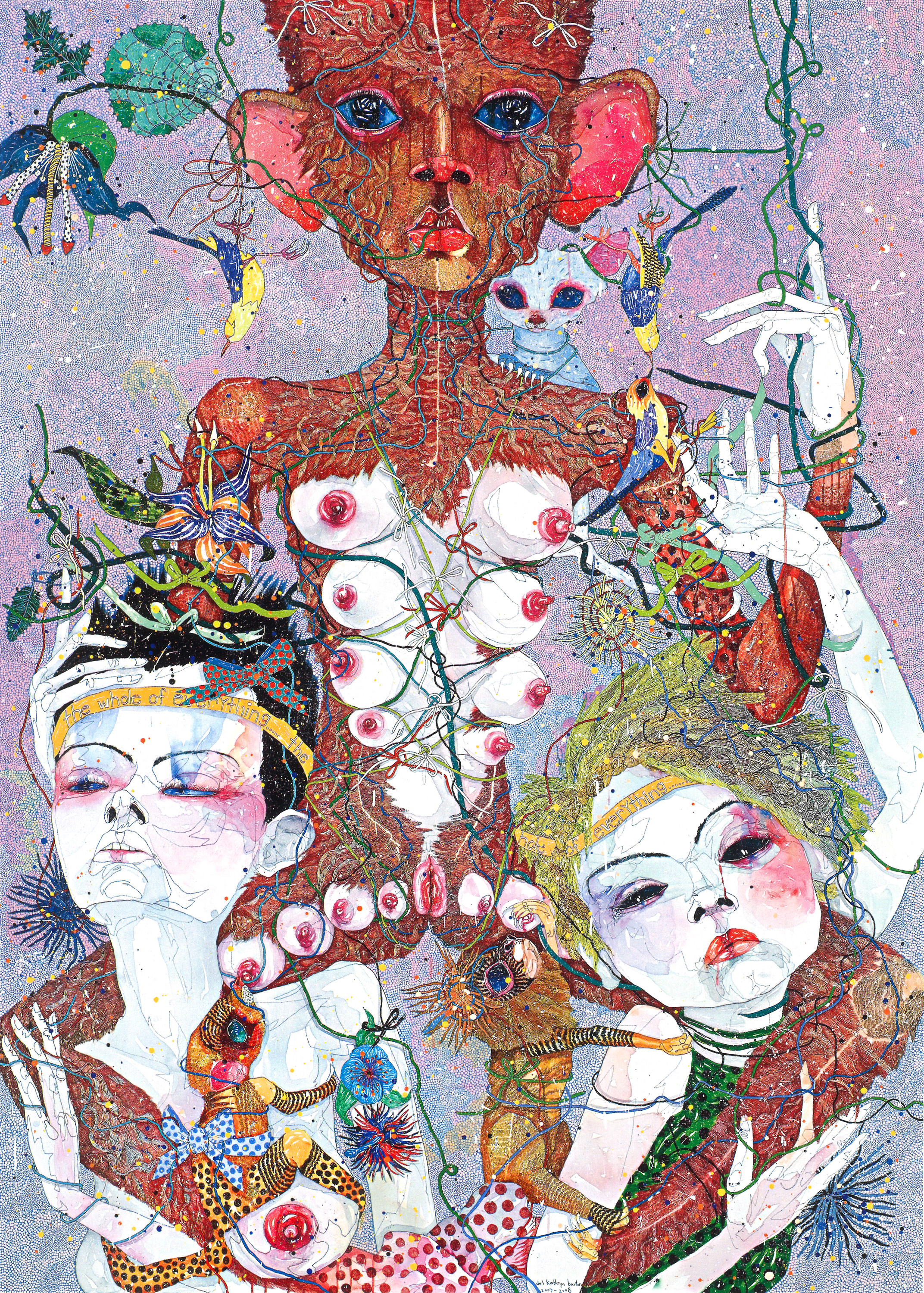
Addressing the inherent tension in Barton’s artworks, between painstaking detail and an intuitively spontaneous creative process, Anthony Gardener writes: ‘What matters most for Barton is what goes on beneath the surface of her figures and their worlds. What concerns her are the forces propelling the creation of those worlds – forces of chance and intuition, exhaustion and drive – of how, in Barton’s own words, ‘the resulting narratives are so much about the quality of the process of their making.’3
Blurring the lines between figure and ground, the tremulous tension of Barton’s cosmic field is echoed in the quivering alertness of her figures and their animal familiars. For the artist, the watchful goddesses and creatures of her world have not escaped the competing emotional burdens we face on Earth. The dark pools of eyes watch from anxious animal faces, while the hirsute goddess stares defiantly with oddly coloured milky eyes. Amongst this optical assault, our eyes are drawn to the porcelain purity of her raw skin, the lilac and rose washes staining her cheeks and breasts, and her pouting cherry-red lips. The spindly angularity of her cheek, sharply bent elbows framing her face and flanked by bony hands seem directly inherited from Egon Schiele. Their fey gestures infer a sacred atmosphere. Consumed by fecund nature, the goddess is entangled, every inch of the canvas is trembling with life force.
Del Kathryn Barton’s work has long addressed complicated and conflicting ideas about motherhood and savage female power through a wide range of media, from the innocent and cutesy girls of her earliest series of painted portraits to the aggressive spider-mother in her short film of 2017, Red. Her depictions of womanhood balance overt eroticism and twee decoration with an inner, darker world of the subconscious. Her figures echo the fantastical femmes fatales of the Symbolist painters, whose subjective expression of universal desires and real anxieties of modern existence deliberately eluded a clear and finite interpretation. As Pip Wallis noted in the catalogue for Barton’s retrospective exhibition at the National Gallery of Victoria, ‘Her works direct us away from our refined, controlled and categorised society towards a mysteriously interconnected world where spirit, psyche, natural cycles and the body are interconnected in intimate, unknowable relationships.’4
1. Del Kathryn Barton, 2008, Art Gallery of New South Wales at: https://www.artgallery.nsw.gov.au/prizes/archibald/2008/28606/ (accessed 26 March 2025)
2. Conversation with artist, cited in Gardner, A., ’Del Kathryn Barton: A paradox of ecstasies’, Art and Australia, Sydney, vol. 45, no. 3, 2008, p. 428
3. ibid.
4. Wallis, P., ‘Matrix Of Desire’, Del Kathryn Barton: Highway is a Disco, National Gallery of Victoria, Melbourne, 2017, p. 6
LUCIE REEVES-SMITH
